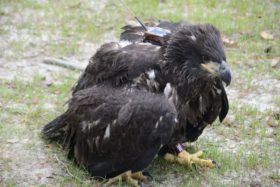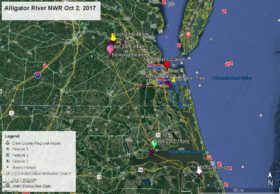Left Eyes – Minor Details
Azalea in Poquoson, VA Feb 18
February 18, 2011Camellia Visits NBG – Spends The Night
February 18, 2011One of the extraordinary benefits of having this particular bald eagle live web cam is the detail we are able to see. Yesterday we had an excellent closeup look at the left eye of both the female and male adults in the Norfolk Botanical Garden bald eagle nest. Birds have excellent eye sight, especially raptors like bald eagles. Minor details like this are important in helping them to identify each other. We don’t often get this close so not much help to us in identifying individual birds, but when we do here is what to look for in these two adults.
The first two photos of the left eye are the female. Note the black spot in the iris. It is below the pupil. The next two photos are the left eye of the male. The black spot in the iris is to the right of the pupil. There are other difference between the two. Do you see them?








6 Comments
Fascinating to have such a close-up look at their eyes! I’ll have to see if i can see this when at “normal” viewing distance, but it appears like her “eyes” (i guess the shape is formed by the eyelids and underlying bone structure?) are round while his are almond shaped. I can also see his “eyeliner” very clearly in these pics.
I do see the difference in shapes and set of their eyes, but the most distinguishing characteristic to me is the shape of the brow.
Wonder where that arched brow of Dad’s fits in the genetic code? Does Buddy have an arch? Etc. LOL
Thanks for posting this comparison, Reese!
his eyes look to be a lighter color than hers do
Poppa seems to have a longer hook on his beak, than momma.
What theories do you have on the cause of the spots on the iris? I band raptors at Cape may point in the fall and I have caught hawks (Sharp-shinned hawks, Coopers Hawk and Red-tailed Hawks) with black spots on the iris, most of them where HY(hatch year) birds.
Response – Good question Arthur. I don’t know, but will try today to find out. I have wondered the same thing. Over the years. I have retrapped several hundred raptors banded at Cape May.
Followup response. Well Arthur, I spent some time today trying to find an answer to your question, because I want to know too. Unfortunately, I did not find the answer I was looking for. The best statement about the matter came from the book Bird Coloration by Geoffrey E. Hill in which he states “Eyes have the most complex and least understood mechanisms of coloration of any part of a bird. The coloration of birds eyes is often a result of both pigmation and crystalline deposits of pigments that create structural coloration.” So, just what causes the black spots in the yellow iris? Still don’t exactly know.